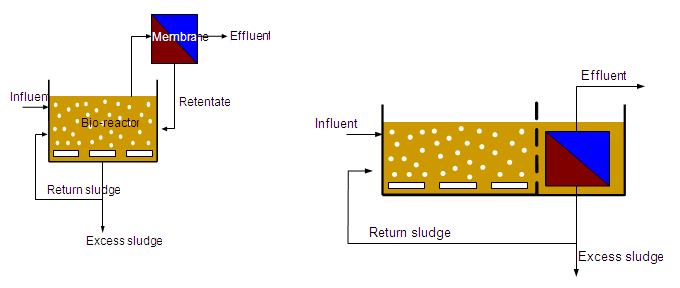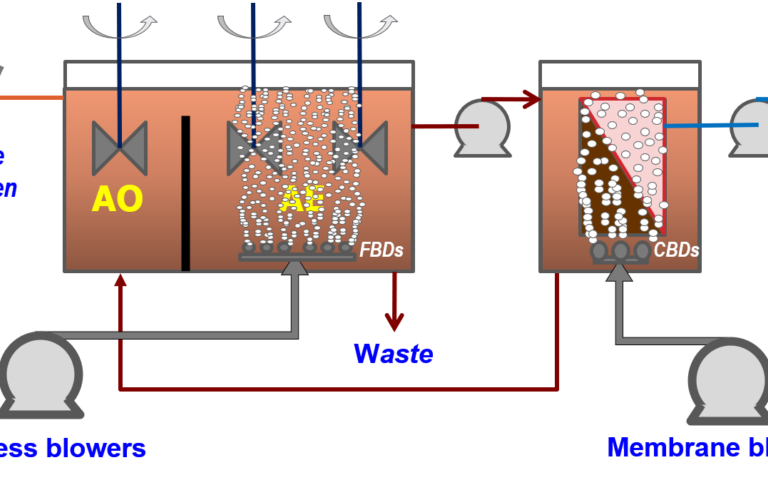How Membrane Bioreactor Technology Is Revolutionizing Wastewater Treatment
How Membrane Bioreactor Technology Is Revolutionizing Wastewater Treatment
Blog Article
The Benefits of Membrane Layer Bioreactors in Lasting Wastewater Management
Membrane layer bioreactors (MBRs) stand for a crucial improvement in sustainable wastewater management, successfully merging organic therapy with advanced membrane purification innovation. As the demand for sustainable options escalates, checking out the complex advantages of MBRs might expose unanticipated effects for the future of wastewater treatment systems.
Review of Membrane Bioreactors
Membrane bioreactors (MBRs) stand for a substantial improvement in wastewater therapy innovation, integrating biological degradation with membrane filtration to enhance the performance of the therapy process. This ingenious system incorporates the benefits of conventional turned on sludge procedures with membrane modern technology, permitting boosted solid-liquid splitting up. MBRs utilize semi-permeable membranes to different treated water from biomass, resulting in premium effluent that can be reused or securely discharged into the environment.
The functional layout of MBRs normally entails a bioreactor where bacteria damage down natural issue, complied with by a membrane device that filterings system the mixed liquor. This arrangement not just decreases the footprint of the treatment center yet additionally enables higher biomass concentrations and minimized hydraulic retention times. MBRs are qualified of dealing with a broader variety of pollutants, including nutrients and virus, making them ideal for numerous applications, from local wastewater therapy to industrial effluent processing.
The integration of MBRs right into wastewater administration systems is a measure of an expanding pattern towards lasting and efficient practices in environmental engineering. Their ability to generate top notch effluent while reducing space requirements settings MBR modern technology as a principal in modern-day wastewater therapy remedies.
Boosted Effluent High Quality

The membrane filtration procedure serves as a physical obstacle, allowing the retention of microbes and particulate issue, which contributes to a clearer and cleaner effluent (Membrane Bioreactor). In addition, MBRs run at greater biomass focus than standard activated sludge systems, promoting extra reliable biodegradation of pollutants. This causes a reduction in biochemical oxygen need (FIGURE) and total put on hold solids (TSS) levels in the final effluent
In addition, MBRs demonstrate superb performance in treating difficult wastewater make-ups, such as commercial effluents and wastewater with high nutrient tons. Therefore, the effluent produced is typically of greater top quality, permitting more versatile disposal alternatives and lowered ecological effect. Ultimately, the improved effluent quality accomplished with MBR innovation emphasizes its crucial duty in progressing lasting wastewater management practices.
Water Reuse Opportunities
The top quality effluent generated by membrane layer bioreactors (MBRs) opens significant chances for water reuse in numerous applications. MBRs successfully eliminate contaminants, consisting of virus, suspended solids, and raw material, leading to cured water that satisfies or exceeds regulatory criteria for reuse. This site top quality enables the execution of water recycling efforts throughout diverse fields.
One prominent application remains in farming, where treated wastewater can be made use of for watering, advertising lasting farming practices while conserving fresh water sources. Additionally, MBR-treated effluent can be utilized for commercial procedures such as cooling, cleansing, and as a procedure water source, significantly reducing the need for potable water in these operations.
In city environments, MBRs promote the usage of redeemed water for landscape irrigation, toilet flushing, and other non-potable usages, adding to the overall durability of water supply systems. The integration of MBR technology in decentralized systems help in managing local water demands, especially in water-scarce regions.
Minimized Environmental Influence
Exactly how can the fostering of membrane layer bioreactors (MBRs) contribute to a lowered environmental influence in wastewater management? MBRs considerably enhance the therapy performance of wastewater while decreasing eco-friendly disruptions. Membrane Bioreactor.
Additionally, MBRs run at reduced hydraulic retention times contrasted to conventional systems, resulting in smaller sized treatment plant impacts. This compact style decreases land usage, thereby maintaining natural environments and biodiversity. The process also creates less sludge than traditional approaches, alleviating disposal obstacles and decreasing greenhouse gas exhausts related to sludge monitoring.
In addition, MBRs help with the healing of useful resources, such as water and nutrients, adding to a circular economic situation. By making it possible for water reuse for irrigation or industrial processes, MBRs assist reduce freshwater deficiency, therefore promoting sustainable water utilize practices. Eventually, the fostering of MBR see technology stands for a substantial stride in the direction of decreasing the environmental influence of wastewater monitoring systems.
Economic Benefits of MBRs

Furthermore, MBRs help with the production of top quality effluent, which can be recycled for numerous applications, such as farming watering and commercial processes - Membrane Bioreactor. This reuse capacity can significantly reduce water purchase costs, offering an economic motivation for markets facing rigid water policies
The portable layout of MBR systems also leads to lowered land demands, which is specifically beneficial in urban locations where property is pricey. By reducing area, districts and sectors can save money on land procurement and upkeep expenditures.
Additionally, MBRs why not find out more frequently require less constant maintenance and have a longer life expectancy than typical systems, further adding to cost savings. In recap, the economic advantages of MBRs-- varying from reduced functional prices to land savings and effluent reuse-- make them a compelling option for lasting wastewater management, supplying both prompt and lasting economic benefits.
Conclusion
Membrane bioreactors represent a transformative method to lasting wastewater monitoring, combining biological therapy with innovative membrane layer filtration for superior effluent high quality. Their capability for reliable pollutant elimination promotes water reuse, consequently conserving crucial freshwater sources. Additionally, MBRs add to decreased ecological impacts with compact styles and reduced sludge generation. Economic benefits further improve their practicality, making MBRs an encouraging service for addressing the difficulties of wastewater therapy and advertising sustainable source management.
Membrane bioreactors (MBRs) stand for a pivotal improvement in sustainable wastewater monitoring, effectively merging organic treatment with innovative membrane layer filtering innovation.Membrane layer bioreactors (MBRs) represent a significant development in wastewater therapy innovation, integrating biological degradation with membrane filtering to enhance the efficiency of the therapy process.Attaining boosted effluent top quality is one of the most considerable benefits of using membrane layer bioreactors (MBRs) in wastewater treatment.In addition, MBRs demonstrate superb performance in dealing with challenging wastewater structures, such as industrial effluents and wastewater with high nutrient lots.Incorporating membrane layer bioreactors (MBRs) right into wastewater administration not just decreases ecological effect but additionally presents substantial financial advantages.
Report this page